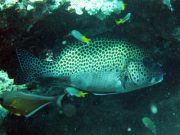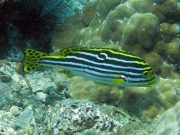Diving with Sweetlips
Lanta Marine Life | Plectorhynchinae
Sweetlips are easily identified from their small mouth, big, fleshy lips and distinctive colour patterns, and are often spotted during Koh Lanta diving trips. Their colours and patterns are highly variable, ranging from uniformly coloured to spotted, blotched, banded and striped.
Normally solitary, or living in small groups or pairs, these bottom dwelling grunts are compressed fish with a strongly outward curving head profile and a groove in the chin. Sweetlips will undergo a series of dramatic colour and pattern changes throughout their lives, with juveniles looking completely different to their adult selves.
Sweetlips can often be seen in small clusters under overhangs, ledges, or in other hiding spots and may occasionally associate with other sweetlips. These fish are bottom-feeding predators and at night they will seek bottom-dwelling invertebrate prey, such as bristle worms, shrimps, and small crabs.
3 species found on this page:
Gold-spotted Sweetlips
(Plectorhinchus flavomaculatus)

Plectorhinchus flavomaculatus @ Hin Bida
The Gold-Spotted Sweetlips has a generally light grey coloured body, with yellowish-gold stripes and spots on the head and small yellowish-gold spots on the upper body, extending onto the dorsal and tail fins. Spots on the fins are often darker. There is a dusky lower margin on the tail fin.
The Gold-Spotted Sweetlips grows to 60 cm, but more usually observed 25 cm - 30 cm. This species is observed solitary, or in small groups and the diet includes small fish and crustaceans.
Harlequin Sweetlips
(Plectorhinchus chaetodonoides)
The Harlequin Sweetlips exhibits wildly contrasting colouring at various stages of its life, with the adult coloration and pattern being very different to the juvenile colouration.
The adult Harlequin Sweetlips has a whitish to yellowish or greenish body, with many small dark brown spots on the head, body and fins. The belly is whitish - greyish, and without spots.

Adult Plectorhinchus chaetodonoides @ Koh Bida
Sub-adult Harlequin Sweetlips are in the transition stage from juvenile to adult and have a whitish body occasionally with yellowish or greenish tinting on the back. The darker body patterns are reminiscent of the juvenile patterns, but starting to fade. The body and tail fin are covered in many small brown spots.
Juvenile Harlequin Sweetlips have a brown body and several large creamy-white, dark-edged blotches. The fins have white margins. Juveniles swim face-down, with a strange undulating, or wave-like wiggle, moving their fins in opposing circular movements. This strange dance is designed to look like a poisonous flatworm or nudibranch in order to deter predators.
Adults can reach 72 cm, but more often observed in the 30 cm range. This species is nocturnal, usually solitary and can be found near ledges on the reef edge. The diet includes crustaceans, molluscs, and fish.
Oriental Sweetlips
(Plectorhinchus vittatus)

Plectorhinchus vittatus @ Koh Bida
The Oriental Sweetlips has a pale grey to white body with black stripes and a yellow face. The black stripes are usually wider on the upper part of the body. All of the fins are yellow, with the dorsal, anal and tail fins having black blotches and spots.
The Oriental Sweetlips can grow to 85 cm, but more usually observed around 25 cm - 30 cm. This is a nocturnal feeder, whose diet includes other smaller fish. Usually encountered solitary, but may form small groups.
Diving with Sweetlips around Koh Lanta
Scuba Diving & Snorkel Trips
If you'd love a chance to spot Sweetlips on one of our daily high season diving trips from Koh Lanta then send us an email to info@diveandrelax.com.
Join our high season speedboat dive trips to some of Thailand's best dive sites and enjoy small groups, short journey times, with a focus on great personal service, safety and fun.
Not yet a certified diver? Learn to Scuba Dive on Koh Lanta with the 3 day SSI Open Water Diver course.
Book online to save 10% on dive trips and scuba courses on Koh Lanta.
Find Out More
Indo-Pacific Marine Life Guides
- Allen, G., Steene, R., Humann, P., DeLoach, N. (2003) Reef Fish Identification, Tropical Pacific. Jacksonville, FL., USA: New World Publications, Inc., ISBN 1-878348-36-1.
- Humann, P., DeLoach, N., (2010) Reef Creature Identification, Tropical Pacific. Jacksonville, FL., USA: New World Publications Inc., ISBN 978-1-878348-44-9
- Debelius, H. (2013) Indian Ocean Reef Guide. Frankfurt, Germany: IKAN - Unterwasserarchiv, ISBN 978-3-939767-52-7.
- Debelius, H. (2004) Nudibranchs and Sea Snails, Indo-Pacific Field Guide. Frankfurt, Germany: IKAN - Unterwasserarchiv, ISBN 3-925919-51-1
- Erhardt, H., Knop, D. (2015) Corals Indo-Pacific Field Guide. Frankfurt, Germany: IKAN - Unterwasserarchiv, ISBN 3-925919-69-4.
- Veron J.E.N., Stafford-Smith M.G., Turak E. and DeVantier L.M. (2016). Corals of the World


